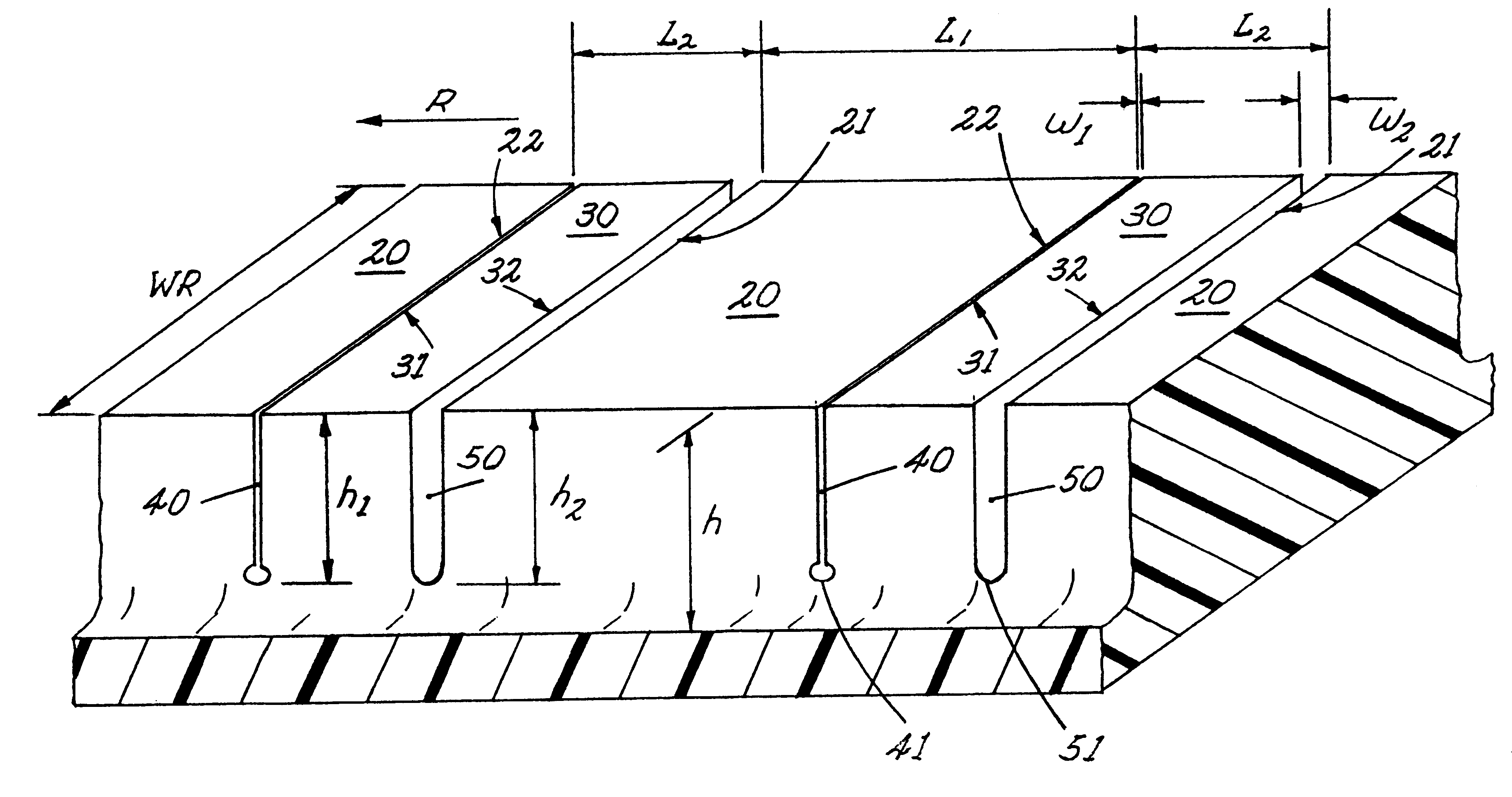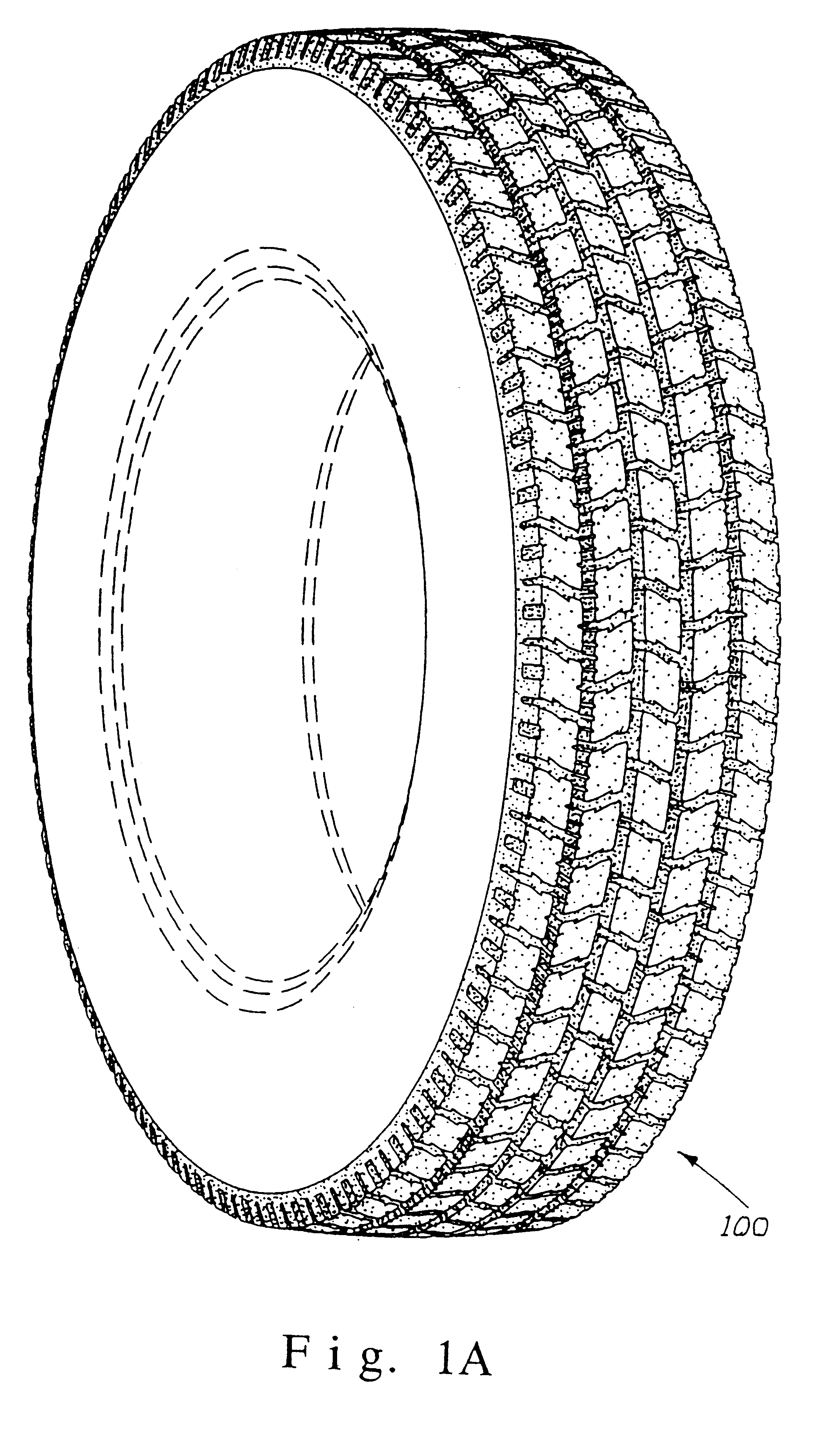Tire having sacrificial bridging
a technology of sacrificial bridging and tire, which is applied in the direction of vehicle components, transportation and packaging, non-skid devices, etc., can solve the problems of tire removal from service, user dissatisfaction, and uneven tread surfa
- Summary
- Abstract
- Description
- Claims
- Application Information
AI Technical Summary
Problems solved by technology
Method used
Image
Examples
first embodiment
The invention disclosed herein can be advantageous for all classes of pneumatic tires where there is a need to improve the compromise between traction capabilities and overall service life. In order to demonstrate the improvements possible with the present invention, three different designs according to this first embodiment were prepared on 275 / 80 R 22.5 heavy duty truck radial tires and then were mounted on the drive axles of 6.times.4 heavy duty trucks operated under highway service conditions. Each design was mounted with a companion set of reference tires. During the course of the test, tread depths and tread surface profiles were measured as well as notations of the appearance of tread surface anomalies. The specifics of the three designs and the reference tire are shown in Table 1.
From the results of these tests, a tire according this embodiment could maintain an acceptable recess and thus d / h for up to 144,000 km (90,000 miles). The results shown in Table 1 clearly demonstra...
second embodiment
the invention is shown in FIGS. 4a and 4b wherein cuts 40 and 50 may be inclined with respect to the outward normal from the tread surface. In these cases the axes of the cuts 40 and 50 have inclination angles .alpha..sub.1 and .alpha..sub.2, respectively, relative to the outward normal from the tread surface. Angle .alpha. is positive when the groove axis is rotated in the direction of tire rotation or counterclockwise as shown in FIGS. 4a and 4b. In the first example shown in FIG. 4a only cut 40 is inclined in the range -15.degree..ltorsim..alpha..sub.1.ltorsim.-5.degree. and preferably .alpha..sub.1 is between about -7.degree. to about -10.degree.. In another example (not shown) only cut 50 is inclined in the range -15.degree..ltorsim..alpha..sub.2.ltorsim.-5.degree. and preferably .alpha..sub.2 is between about -7.degree. to about -10.degree.. For the example shown in FIG. 4b, both cuts 40 and 50 are inclined and .alpha..sub.1 and .alpha..sub.2 have negative values. In the examp...
third embodiment
In a third embodiment according to the invention, as shown for tire 400 in FIGS. 5a and 5b, increased sliding of the sacrificial bridge is accomplished by increasing the width of second cut 50 relative to the widths disclosed for the first embodiment. Another advantage of this embodiment is that increased sliding of the sacrificial bridge produces an accelerated initial rate of rubber loss from the sacrificial bridge. This permits the sacrificial bridge of the tread to initially have no depression (d / h=0), a potential advantage in further preventing the early appearance of tread surface anomalies, while thereafter developing a non-zero value of d / h. Thus both increased service life and traction on the used tire are obtained. It is not desirable to have an excessive amount of tread surface area as sacrificial regions for reasons of tire service life. Thus tire 400 has a narrow first cut 40 of width w.sub.1 close to the trailing edge of a first block 30 increased width w.sub.2 of seco...
PUM
 Login to View More
Login to View More Abstract
Description
Claims
Application Information
 Login to View More
Login to View More - R&D
- Intellectual Property
- Life Sciences
- Materials
- Tech Scout
- Unparalleled Data Quality
- Higher Quality Content
- 60% Fewer Hallucinations
Browse by: Latest US Patents, China's latest patents, Technical Efficacy Thesaurus, Application Domain, Technology Topic, Popular Technical Reports.
© 2025 PatSnap. All rights reserved.Legal|Privacy policy|Modern Slavery Act Transparency Statement|Sitemap|About US| Contact US: help@patsnap.com



